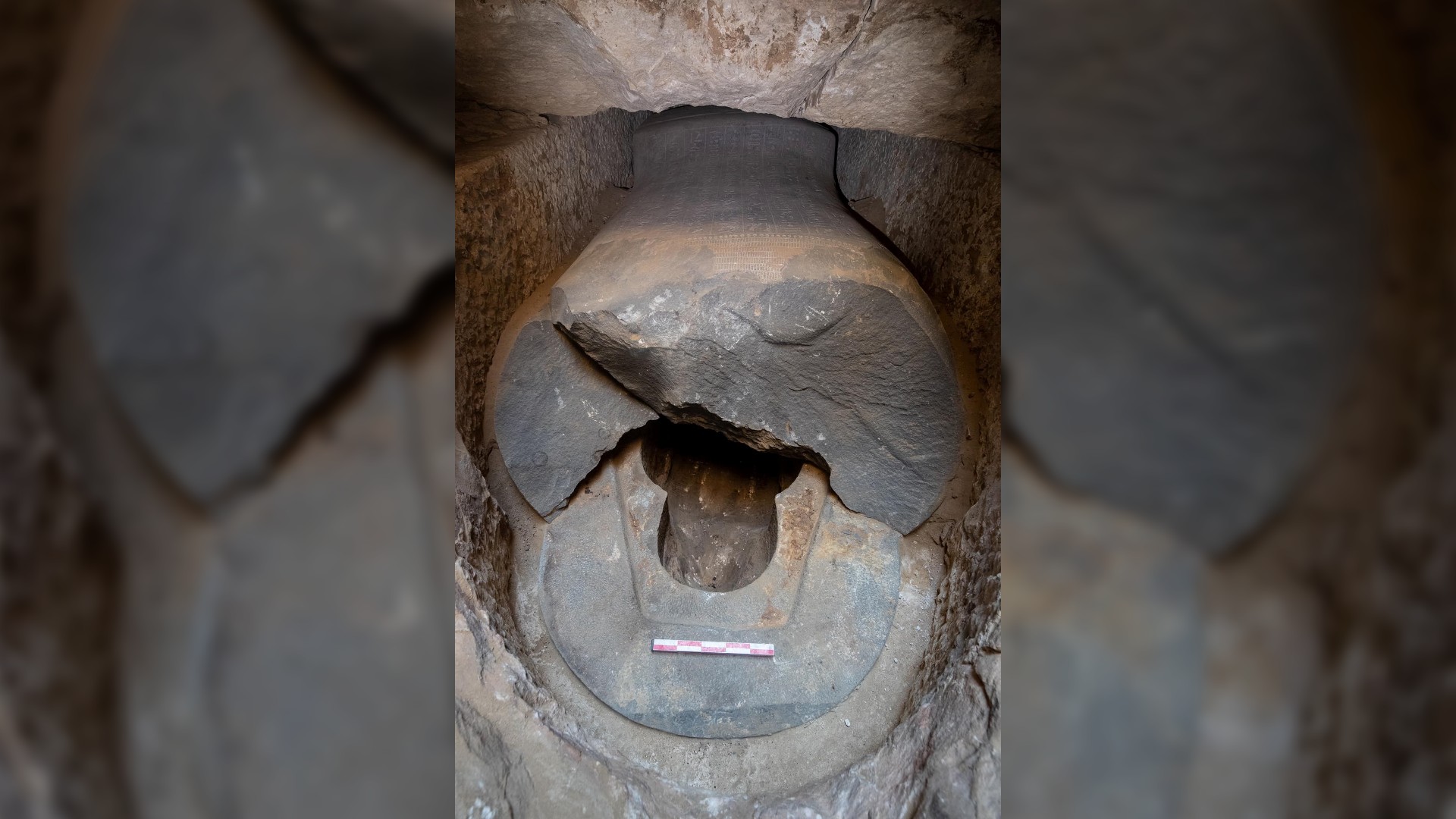Tomb of ancient Egyptian mercenary commander found in Egypt
The discovery includes the largest embalming cache ever found in Egypt.

Archaeologists in Egypt have discovered a 2,600-year-old tomb belonging to a man of high status: a "commander of foreign mercenaries" named "Wahibre-mery-Neith."
The tomb's embalming cache, found in 2021, includes more than 370 pottery storage jars containing materials used in the commander's mummification, making it the "largest embalming cache ever found in Egypt," a team of Egyptian and Czech researchers said in a statement. The tomb is buried at Abusir (also spelled Abū Ṣīr), a few miles south of the giant necropolis at Saqqara.
Grave robbers stole Wahibre-mery-Neith's mummy in antiquity, but archaeologists located remains of his sarcophagus that have hieroglyphs inscribed on them. The glyphs give his identity and quote part of chapter 72 of the Book of the Dead that describes "the resurrection of the deceased and his departure to the afterlife," according to the statement.
In his role as commander of ancient Egypt's mercenary troops, Wahibre-mery-Neith would have "supervised and commanded mercenaries coming from the Aegean islands and Asia Minor," the statement said.
Related: Why does the Rosetta Stone have 3 kinds of writing?



The commander lived during either the late 26th dynasty (circa 688 B.C. to 525 B.C.) or early 27th dynasty (525 B.C to 404 B.C.), according to the statement. While Egypt was independent during the 26th dynasty, the 27th dynasty saw the country be conquered and ruled by the Persians.
Despite the growing foreign influence, Wahibre-mery-Neith appears to be of 'local descent," according to his name and artifacts found in his tomb, Miroslav Bárta, the director of Czech excavations in Egypt, told Live Science in an email. Why he was buried with the largest known embalming cache from ancient Egypt is uncertain. "This is a difficult question and at this stage of analysis we don't know," Bárta said.
Get the world’s most fascinating discoveries delivered straight to your inbox.
The commander was also buried with 402 faience (glazed ceramic) shabti figurines. The ancient Egyptians believe that shabtis worked for the deceased in the afterlife and they are commonly found in Egyptian tombs. The finds also include a heart scarab, an amulet and an ostracon (pottery shard) inscribed with more spells from the Book of the Dead.
Scholars react
Live Science contacted several scholars not affiliated with the research to get their thoughts on the finds. They all found it to be an interesting discovery. "It's certainly an important, interesting and most welcome discovery, although not unique in this area: the Czechs have been working in Abusir for more than twenty years already, they unearthed several tombs of high officials of the late 26th and early 27th dynasty," Günter Vittmann, a professor of Egyptology at the Julius Maximilian University of Würzburg in Germany, told Live Science in an email.
Depending on exactly which time period he lived, the commander's life could have been quite different. "I think our Wahibre lived most of his life, maybe all of his life, during the 26th [dynasty]" Benjamin Sullivan, a lecturer in ancient history at Arizona State University, told Live Science in an email. He doubted that Wahibre would have boasted about being a "commander of foreign mercenaries" if he lived during the 27th dynasty — the time when the Persians ruled ancient Egypt. Additionally, Sullivan noted that this title was more commonly used during the 26th dynasty.
It's interesting that there was no armor or weapons found in the tomb, noted Daniel Gómez-Castro, a historian who has researched and written extensively about Greek mercenaries in the ancient world. It's possible that Wahibre was not a warrior/battlefield commander, but rather a political appointee who handled administrative tasks, such as making sure the mercenaries got paid, Gómez-Castro said. If Wahibre lived during the time when the Persians controlled Egypt, he could be the relative of a "Dinast," a person appointed by the Persians who had some local authority.
If the tomb does date to the time of Persian rule, then it illustrates that the "Persians were so confident in their rule that they entrusted such an important task to local dignitaries," Stefan Pfeiffer, a professor of ancient history at Martin Luther University of Halle-Wittenberg in Germany, told Live Science in an email. It wouldn't be the only time the Persians did this. A tomb belonging to an Egyptian named Udjahorresnet dates to the time of Persian rule, and he served as a senior official for the Persians, Pfeiffer noted.
Originally published on Live Science.

Owen Jarus is a regular contributor to Live Science who writes about archaeology and humans' past. He has also written for The Independent (UK), The Canadian Press (CP) and The Associated Press (AP), among others. Owen has a bachelor of arts degree from the University of Toronto and a journalism degree from Ryerson University.


